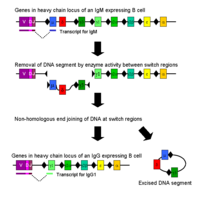
Photo from wikipedia
Activation-induced cytidine deaminase (AID) initiates immunoglobulin (Ig) class switch recombination (CSR), somatic hypermutation (SHM), and gene conversion by converting DNA cytosines to uracils at specific genomic regions. In this study,… Click to show full abstract
Activation-induced cytidine deaminase (AID) initiates immunoglobulin (Ig) class switch recombination (CSR), somatic hypermutation (SHM), and gene conversion by converting DNA cytosines to uracils at specific genomic regions. In this study, we examined AID footprints across the entire length of an engineered switch region in cells ablated for uracil repair. We found that AID deamination occurs predominantly at WRC hot spots (where W is A or T and R is A or G) and that the deamination frequency remains constant across the entire switch region. ABSTRACT Activation-induced cytidine deaminase (AID) initiates immunoglobulin (Ig) class switch recombination (CSR), somatic hypermutation (SHM), and gene conversion by converting DNA cytosines to uracils at specific genomic regions. In this study, we examined AID footprints across the entire length of an engineered switch region in cells ablated for uracil repair. We found that AID deamination occurs predominantly at WRC hot spots (where W is A or T and R is A or G) and that the deamination frequency remains constant across the entire switch region. Importantly, we analyzed monoallelic AID deamination footprints on both DNA strands occurring within a single cell cycle. We found that AID generates few and mostly isolated uracils in the switch region, although processive AID deaminations are evident in some molecules. The frequency of molecules containing deamination on both DNA strands at the acceptor switch region correlates with the class switch efficiency, raising the possibility that the minimal requirement for DNA double-strand break (DSB) formation is as low as even one AID deamination event on both DNA strands.
Journal Title: Molecular and Cellular Biology
Year Published: 2020
Link to full text (if available)
Share on Social Media: Sign Up to like & get
recommendations!